Frida Kahlo’s art is very personal and unique. Her art gives us a glimpse into her life which was filled with pain and suffering. That is why to understand Frida Kahlo’s art, you need to understand a bit about her life.
Frida Kahlo is one of Mexico’s premier artists. She suffered from polio and was in a bus accident that left her in great pain. Kahlo married the famous Mexican artist Diego Rivera. She is well known for her self-portraits that depict pain and suffering and are filled with passion and bright, bold, vibrant colors. Her art is a personal statement of her life, painting, and culture.
Table of Contents
- About Frida Kahlo
- Frida Kahlo’s Artwork
- Frida Kahlo’s Legacy
- The Frida Kahlo Museum – The Blue House
- Frequently Asked Questions About the Mexican Artist Frida Kahlo
- Related Questions
Frida Kahlo’s art was very personal. She painted a lot of self-portraits. And those that were self-portraits she may have painted about people she knew as her husband Diego Rivera.
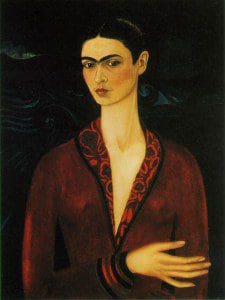
About Frida Kahlo
Frida Kahlo did not set out to become an artist, but due to unforeseen circumstances, her life drastically changed, and a new dream to become an artist emerged.
Frida Kahlo – The Early Years
Frida Kahlo was born in Mexico City in 1907 as Magdalena Carmen Frida Kahlo y Calderon in the Caza Azul or the Blue House in Coyoacan, Mexico City. Throughout her life, she was known by the name Frida Kahlo. Later in her life, she would tell people that she was born in 1910, which was the year of the Mexican Revolution.
She was born in humble circumstances to a German father and a mestizo mother. A mestizo or mestiza person refers to a person who has a combination of both European and Indigenous American blood and descent. Her father was a photographer.
Frida described the atmosphere of her childhood home as extremely sad. Both of her parents were often sick. Her relationship with her mother was strained, whereas she got on quite well with her father.
In speaking of her father, she said:
“I am in agreement with everything my father taught me and nothing my mother taught me.”
frida Kahlo
Frida spent most of her childhood and adulthood at La Casa Azul in Coyoacan, Mexico City. La Casa Azul is also known as the Blue House, as the house has bright cobalt blue walls. Today it is the Frida Kahlo Museum.
The Fight Against Polio
As a child, Frida Kahlo contracted polio. This left her with one leg that was shorter and thinner than the other leg. In speaking of her feet, Frida Kahlo said:
“Feet, what do I need you for when I have wings to fly?”
frida Kahlo
Because of this, she spent a lot of time at home during her growing up years being homeschooled. She also started school much later than other children her age.
Because of her deformity, she was often bullied. This experience also made her a recluse for many of her younger years.
But despite this hardship she had with polio, she was a very promising student. She had been accepted to the National Preparatory School in pre-medicine. At the time, out of 2,000 students, only 35 girls had been accepted into the school. She had performed extremely well and, at 18, was on her way to becoming a doctor.
At school, Frida became well-known for being brave and outspoken. It was also at this school that, in 1922, she first met Diego Rivera, who was painting a mural for the school.
Frida, along with many of her friends from school. joined a group that had similar political and intellectual views as the Mexican Communist Party (PCM). Diego Rivera was a prominent member of the Mexican Communist Party.
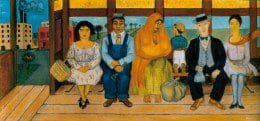
The Bus Accident
In September 1924, Kahlo and her boyfriend were on their way home from school when the wooden bus they were riding seriously collided with a streetcar. Several people died.
Kahlo and her boyfriend both survived the accident. But she was very badly hurt and spent months in the hospital. This accident was to leave her in pain and her health fragile her entire life. From the accident, she had suffered from multiple fractures of her spine, collarbone, and ribs, along with a shattered pelvis, broken foot, and a dislocated shoulder.
She was so beaten up and badly broken that she was lucky to be alive. She knew with all the damages she had suffered, she could never physically become a doctor as her injuries were just too severe and damaging. The damage was so severe that over her lifetime, she had over 30 operations.
It was also at this time that Kahlo started to return to her childhood hobby of art and painting. Her parents encouraged her to paint and made her a special easel, and gave her paint supplies so that she could paint in bed while she was still in her full-body cast.
Living through something as painful as this would be difficult for anyone. But to have suffered both polio and the accident would have been unbearable for many people. In speaking of her sorrows, Frida said:
“I tried to drown my sorrows, but the bastards learned how to swim, and now I am overwhelmed by this decent and good feeling.”
frida kahlo
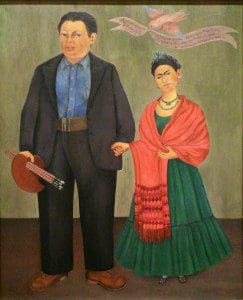
Marriage to the Mexican Artist Diego Rivera
As Kahlo started to paint, she wanted to know if she had any talent as an artist. Her parents had spent a lot of money they did not have on all her operations, so she wanted to try to find a way to earn a living.
In 1928 she reconnected with Diego Rivera and asked him to look at and critique her artwork and her talent as an artist. He told her that she was very talented and that she had a gift and should continue painting.
Besides their interest in art, Frida and Diego also had similar political views with their activism in the Mexican Communist Party. They attended many of the same parties and political events as the Mexican Communist Party.
Diego was twenty years older than Kahlo and had two previous common-law wives and countless affairs. In total, Diego would marry five times in his lifetime. Frida and Diego were married in a civil ceremony in 1929, or 7 years after they met at her school in 1922.
Diego was wealthy, so he was able to help her family financially. But by all accounts, her marriage to Diego was not an easy one.
As Diego was a very large man, Frida was tiny and petite. He was over 6 feet tall and weighed over 300 pounds. She, on the other hand, was about 5’3″ and only about 98 pounds. Her mother did not approve of the marriage. And her parents said their marriage was:
“marriage between an elephant and a dove”
Smithsonian
Frida admits that her marriage to Diego was difficult, though they were together until her death. Frida said this about her relationship with Diego:
“Perhaps it is expected that I should lament about how I have suffered living with a man like Diego. But I do not think that the banks of a river suffer because they let the river flow, nor does the earth suffer because of the rains, nor does the atom suffer for letting its energy escape. To my way of thinking, everything has its natural compensation.”
Frida Kahlo
Frida Kahlo – Wife of Master Painter Diego
In 1930 Frida and Diego moved to San Francisco, California, and the latter to Detroit, Michigan. It was in San Franciso that Frida started to become extremely productive with her painting. She also started to further develop the Mexican folk art style of her artwork. She also participated in her first exhibition in San Francisco.
In Detroit, she experienced a failed pregnancy and other health problems. But she also continued in her art as she experimented with different techniques like etching and frescos. It was also during this period that many of her paintings also started to show themes of pain, suffering, wounds, and terror.
In Detroit, she also had another exhibition of her artwork. She gave an interview to the Detroit News, and the article was entitled:
“Wife of the Master Mural Painter Gleefully Dabbles in the Works of Art”
Detriot Newspaper Article
Even though Kahlo was a wonderfully accomplished artist, her work was not taken very seriously. Instead, she was seen as just the wife of Diego Rivera, who was “dabbling” in art.
Turbulent and Affairs-Filled Marriage.
In 1934 Frida and Diego returned to Mexico City. During this period, she would go through periods of not painting to times when she would be extremely productive. In part, this could have been because her home life and marriage to Diego were in deep trouble.
Frida discovered her husband Diego was having an affair with her sister Cristina Cristina was recently divorced and had two children from her previous husband.
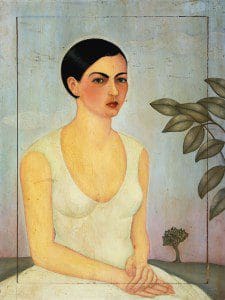
This betrayal hurt Frida. She was so saddened that she cut off her long hair to show her desperation for the betrayal. Added to this was that over many of these years, though she longed for children, she could not have any and suffered several miscarriages.
In speaking again of her relationship with Diego, she said:
“There have been two great accidents in my life. One was the trolley, and the other was Diego. Diego was by far the worst.”
frida kahlo
Frida was a loving aunt to Cristina’s children. Cristina, Diego, and Frida all lived together. Diego and Frida would divorce and then about a year later would marry again. Their marriage was always a volatile one, and both Frida and Diego had hosts of illicit liaisons and infidelities throughout their relationship.
Frida was known to be bi-sexual as she had affairs with both men and women. She had an affair with Leon Trotsky, the famous Russian revolutionary and founder of the Red Army.
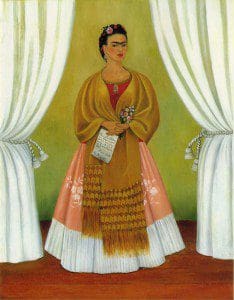
Throughout her life, Frida was politically active and involved in political causes. The injustices between the rich and poor were always very important to her. In speaking of this, she said:
“It is terrifying to see the rich having parties day and night while thousands and thousands of people are dying of hunger…“
frida Kahlo
Exhibitions in New York and Paris
Her overseas exhibitions in places like New York and Paris helped Frida to become a more recognized and important Mexican artist. Her New York exhibition went very well.
Her Paris exhibition did not go very well, this was in part because, at the time, Europe facing the second World War. Even though the Louvre purchased one of her paintings, she still did not take very well to Paris and her Paris experience. In speaking of her exhibition in Paris, she said:
“They are so damn ‘intellectual’ and rotten that I can’t stand them anymore…I would rather sit on the floor in the market of Toluca and sell tortillas, than have anything to do with those ‘artistic’ bitches of Paris.”
Frida Kahlo
Frida still continued to struggle to make any money from her art until the mid to late 1940s. One reason is that she refused to adapt her artistic style to suit any clients’ or potential clients’ wishes. She remained true to her artistic style.
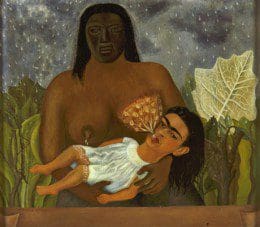
Recognition in Mexico and Abroad
Slowly Kahlo’s art started to become more recognized and accepted in Mexico. She became a founding member of Seminario de Cultura Mexicana, a group of 24 Mexican artists.
The group Seminario de Cultura Mexicana was a group founded in 1942 by the Mexican Ministry of Public Education. The purpose of the group was to spread and promote Mexican culture. It was through her participation in this group that she started to exhibit her work in Mexico.
In 1943 Kahlo accepted a teaching position at the National de Pintura, Escultua y Grabado “La Esmeralda” This was an art school in Mexico City that teaches Painting, Sculpture, and Printmaking. Diego Rivera also taught at this school, as did other notable Mexican artists.
When her health got so bad that she could no longer teach, she started holding art lessons with her students at her home La Casa Azul. She was, by all accounts, a beloved teacher with many devoted students.
In speaking of her artwork, she said:
“I have never expected anything from my work but the satisfaction I could get from it by the very fact of painting and saying what I couldn’t say otherwise.”
Frida Kahlo
The Last Years of Life
In the 1950s, Kahlo’s health condition declined. She was diagnosed with gangrene in the right foot and was bedridden for at least nine months.
She continued working on her paintings, and despite all these hardships and her illness, she had a solo exhibition in Mexico in 1953. She was so ill that she arrived at the opening ceremony by ambulance and greeted the attendees on a bed set up for her in the gallery.
A few months after this, her right leg was amputated from gangrene. All of these health setbacks put her into a deep depression. She was said to have even contemplated suicide.
Frida died in 1954 in her lovely blue house just a week after her 47th birthday. The official report was that she died of a pulmonary embolism, but there is speculation that she died of self-inflicted suicide.
A few days before her death, she wrote in her diary:
“I hope the exit is joyful – and I hope never to return.”
Frida Kahlo
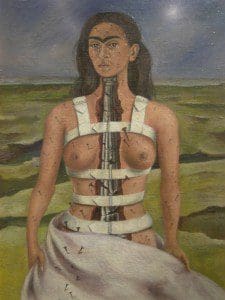
Frida Kahlo’s Artwork
Many things make Frida Kahlo’s art so appealing. Among one is the message of pain that is such an intricate part of so many of her paintings. When you look at her life and all the pain she went through, there is no wonder that she painted about pain and suffering so much.
In speaking of her artwork, she said:
“My painting carries with it the message of pain.“
Frida Kahlo
7 Reasons Frida Kahlo’s Art Is Appealing
Many things make Frida Kahlo’s art appealing. Here are some of them:
- Vibrant Colors – Kahlo used a lot of vibrant colors in her paintings.
- Life experience – One of the major themes of her paintings is her life experiences.
- Personal – Her painting is very personal They give us a glimpse into Frida Kahlo and her life.
- Pain and suffering – On the canvas, she shows both the physical and emotional pain she was suffering. This is evident in paintings like The Broken Column, where she painted herself split down the middle, stark naked as a broken column, her skin dotted with nails and a surgical brace, and being held up by a metal pipe.
- Self Portraits – Of her 143 paintings, 55 of them are self-portraits.
- Mexican folklore – She put a lot of Mexican folklore into her paintings. She shows this in some of the artifacts and jewelry she wears in her portraits.
- Nature – Many of her paintings show elements of nature in them, such as vines, trees, and animals. A great example is her painting called Roots.
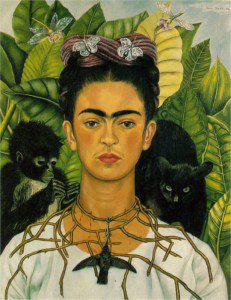
Frida Kahlo’s Legacy
During her lifetime Kahlo was only moderately successful. She did not even sell her first painting until 1938. It was her husband Diego Rivera, that was very well known. She was mainly known as “Diego Rivera’s wife.”
But today, that has all changed. It is Frida whose work is more popular than her husband Rivera’s work. She has worldwide popularity and fame, and most people now know Rivera as “Frida Kahlo’s husband.”
She is so popular that numerous books, documentaries, and movies have been made about her life and art. Here are some of the more notable ones:
- Frida: The Biography of Frida Kahlo – The book Frida: The Biography of Frida Kahlo (1983) by Hayden Herrara. This book is about her life and also her relationship with Diego Rivera.
- Frida, Naturaleza Viva – Translated this means to Frida, Still Life. This is a 1983 Mexican film about her life. This film was directed by the Mexican director Paul Leduc and was a huge success.
- Frida – This Hollywood film was produced in 2002. Salma Hayek played Frida Kahlo. The film won two academy awards.
The Frida Kahlo Museum – The Blue House
After she died in 1954, Diego turned the Blue House, where Frida was born and had also died into a museum to celebrate her legacy and artwork. The museum is located in one of the oldest and most beautiful neighborhoods in Mexico City.
The Caza Azul, or the Blue House, hosts many of Frida Kahlo’s objects. It also reveals to us all more about the life and work of this celebrated artist. The museum shows some of her most important artwork.
The Frida Kahlo Museum is one of the most popular museums in Mexico City, Mexico. You can find out more about the Frida Kahlo Museum by clicking here.
Frida Kahlo is an amazing artist who has an amazing life story to tell. We understand more about her work as an artist as we understand more about her life.
Anita Louise Art is dedicated to art education, great artists, and inspiring others to find and create their art. We love art that uplifts and inspires. #ArtToMakeYouSmile! #ArtToMakeYouHappy!
If you want to see any of my art, you can find out more by clicking here. If you are interested in what inspires me and my paintings, you can discover more by clicking here.
We have a free newsletter and would love you to be part of our community; you can subscribe to the newsletter by clicking here. If you have any questions, I would be happy to talk to you anytime. You can reach me, Anita, by clicking here.
Subscribe to our Anita Louise Art YouTube Channel with great videos and information by clicking here.
Join us for our podcast “5 Minutes With Art.” Spend 5 minutes a week with us to discover and learn about great art and artists. You can find out more about our podcast by clicking here.
Frequently Asked Questions About the Mexican Artist Frida Kahlo
Who is Frida Kahlo?
Frida Kahlo was a Mexican artist known for her vibrant and expressive self-portraits, as well as her exploration of Mexican culture and identity.
When was Frida Kahlo born?
Frida Kahlo was born on July 6, 1907, in Mexico City, Mexico.
What was Frida Kahlo’s artistic style?
Frida Kahlo’s artistic style was characterized by using bright colors, bold patterns, and symbolic imagery to explore themes of identity, culture, and the human condition.
What was Frida Kahlo’s relationship with Diego Rivera?
Frida Kahlo had a tumultuous relationship with Diego Rivera, a prominent Mexican muralist and fellow artist. They were married twice, and their relationship was marked by infidelity and artistic collaboration.
What was Frida Kahlo’s health like?
Frida Kahlo suffered from chronic health problems, including polio as a child and a severe bus accident that left her with lifelong injuries and pain.
What is Frida Kahlo’s most famous painting?
Frida Kahlo’s most famous painting is “The Two Fridas,” which depicts two versions of herself sitting side by side, each holding hands and connected by a shared artery.
What was the significance of Frida Kahlo’s unibrow and facial hair?
Frida Kahlo’s unibrow and facial hair were important aspects of her self-presentation and challenged traditional notions of beauty and femininity.
What is the Casa Azul?
The Casa Azul, or Blue House, is the home in Mexico City where Frida Kahlo was born and where she lived with Diego Rivera for many years. It is now a museum dedicated to her life and work.
What impact did Frida Kahlo have on the art world?
Frida Kahlo’s work has had a significant impact on the art world, inspiring countless artists and feminists with her bold and unapologetic depictions of female identity and experience.
When did Frida Kahlo die?
Frida Kahlo died on July 13, 1954, at the age of 47, due to complications from her health problems.
Related Questions
Was the Mexican Artist Frida Kahlo (1907-1954) A Surrealism Artist?
Frida Kahlo had a life filled with a lot of pain and suffering. She painted her pain and suffering on her canvas. Andre Breton, head of the Surrealism movement, mistakenly labeled Friday Kahlo as a Surrealism Artist, but Frida Kahlo never considered her art to be Surrealism Art.
You can read more about this by reading our blog Was the Mexican Artist Frida Kahlo (1907-1954) A Surrealism Artist? by clicking here.
Who Was The Western American Artist Minerva Teichert (1888-1976)?
Minerva Teichert was a cowgirl from Idaho who loved art. She was so determined to study art that she studied art in both Chicago and New York. Minerva is known for her artwork of daily life in the western United States, other historical events, and scenes from the scriptures.
You can find out more about Minerva Teichert by reading our blog Who Was The Western American Artist Minerva Teichert (1888-1976)? by clicking here.
Who Is the Swedish Artist Sigrid Hjerten (1885-1948)?
Today, Sigrid Hjerten is considered one of Sweden’s most important modern artists. She married the Swedish artist Issac Grunewald. Sigrid and Grunewald studied together in Paris, France, under the French painter Henri Matisse. What made Sigrid stand out is that her artwork was very personal and extremely daring for this period. She suffered from mental illness and died young in Stockholm, Sweden in 1948.
You can learn more about Sigrid Hjerten by reading our blog, Who Is the Swedish Artist Sigrid Hjerten (1885-1948)? by clicking here.

